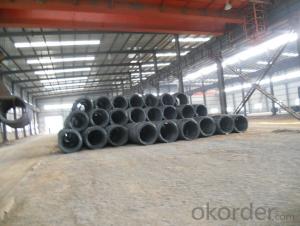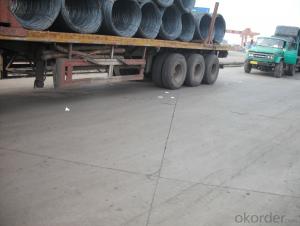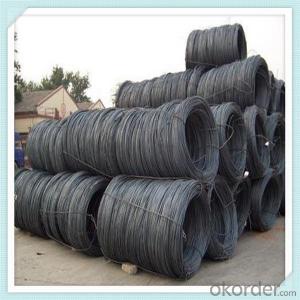Wire Rod , Hot Rolled Carbon Steel Wire Rod SAE1008
- Loading Port:
- Tianjin
- Payment Terms:
- TT or LC
- Min Order Qty:
- 25 m.t.
- Supply Capability:
- 200000 m.t./month
OKorder Service Pledge
OKorder Financial Service
You Might Also Like
OKorder is Wire Rod , Hot Rolled Carbon Steel Wire Rod SAE1008 at great prices with worldwide shipping. Our supplier is a world-class manufacturer of steel, with our products utilized the world over. OKorder annually supplies products to European, North American and Asian markets. We provide quotations within 24 hours of receiving an inquiry and guarantee competitive prices.
Product Applications:
Wire Rod , Hot Rolled Carbon Steel Wire Rod SAE1008 are ideal for structural applications and are widely used in the construction of buildings and bridges, and the manufacturing, petrochemical, and transportation industries.
Product Advantages:
OKorder's Wire Rod , Hot Rolled Carbon Steel Wire Rod SAE1008 are durable, strong, and resist corrosion.
Main Product Features:
· Premium quality
· Prompt delivery & seaworthy packing (30 days after receiving deposit)
· Corrosion resistance
· Can be recycled and reused
· Mill test certification
· Professional Service
· Competitive pricing
Product Specifications:
1.Hot-rolled steel wire rod for building/construction
2.Near the seaport,low logistic cost
3.High precision,5-12mm
Product |
wire rod |
| Standard | AISI, ASTM, BS, DIN, GB, JIS |
| Material/steel grade | Q195-Q235,SAE1006B, SAE1008B, SAE1010B, SAE1018B, or according to customers requirements |
| Wire Gauge | 5.5-12mm |
| Coil weight | 1.8-2.1mts |
| MOQ | 25MT |
| Delivery Time | 15-30 days after receipt of L/C or deposit by T/T |
| Packing | In coil and load in container, if large quantity, by bulk vessel; Can be packed as customers' special requirements |
| Payment terms | 1).100% irrevocable L/C at sight. 2).30% T/T prepaid and the balance against the copy of B/L. 3).30% T/T prepaid and the balance against L/C |
| Application | widely used in machinery parts, manufacturing industry, electronics industry, metal tools and others |
FAQ:
Q1: Why buy Materials & Equipment from OKorder.com?
A1: All products offered byOKorder.com are carefully selected from China's most reliable manufacturing enterprises. Through its ISO certifications, OKorder.com adheres to the highest standards and a commitment to supply chain safety and customer satisfaction.
Q2: How do we guarantee the quality of our products?
A2: We have established an advanced quality management system which conducts strict quality tests at every step, from raw materials to the final product. At the same time, we provide extensive follow-up service assurances as required.
Q3: How soon can we receive the product after purchase?
A3: Within three days of placing an order, we will begin production. The specific shipping date is dependent upon international and government factors, but is typically 7 to 10 workdays.




- Q: Can steel angles be used for signposts and traffic signals?
- Yes, steel angles can be used for signposts and traffic signals. Steel angles are commonly used in construction and engineering projects due to their strength and durability. They provide excellent support and stability, making them suitable for applications such as signposts and traffic signals that need to withstand various weather conditions and potential impacts. Additionally, steel angles can be easily customized and fabricated to meet the specific requirements of different signpost and traffic signal designs, making them a versatile choice for these structures. Overall, steel angles are a reliable and commonly used material for signposts and traffic signals due to their strength, durability, and versatility.
- Q: Can steel angles be used for architectural detailing?
- Yes, steel angles can be used for architectural detailing. Steel angles are versatile structural elements that can be used in various architectural applications. They provide stability and support to structures and can be used for framing, bracing, and reinforcing purposes. Steel angles can be seen in architectural details such as window frames, door frames, staircases, and handrails, among others. They offer strength and durability, making them suitable for both interior and exterior architectural designs. Additionally, steel angles can be easily customized and fabricated to meet specific design requirements, allowing architects to create unique and aesthetically pleasing architectural details.
- Q: Can steel angles be used for cable trays?
- Yes, steel angles can be used for cable trays. Steel angles provide strength and support, making them suitable for holding cables and providing a stable structure for cable trays. The rigid and durable nature of steel angles ensures that the cable trays can withstand the weight of the cables and any additional loads. Additionally, steel angles can be easily fabricated and customized to fit specific requirements, making them a versatile choice for cable tray installations.
- Q: How do you join two steel angles together?
- To join two steel angles together, there are several methods you can use depending on the specific application and requirements. Here are a few common techniques: 1. Welding: Welding is the most common method used to join steel angles. It involves heating the joint to a high temperature and melting a filler material, usually a compatible metal, to fuse the two angles together. This creates a strong and permanent bond. Welding requires specialized equipment and expertise, so it is typically done by trained professionals. 2. Bolting: Another method is to use bolts or screws to connect the two steel angles. This involves drilling holes through both angles and then securing them with appropriate fasteners. Bolting allows for easier disassembly and modification if needed. However, it may not provide the same level of strength as welding. 3. Riveting: Riveting is a technique that uses metal pins or bolts called rivets to hold the steel angles together. It involves drilling holes through the angles and inserting the rivets, which are then hammered or pressed to form a permanent joint. Riveting is commonly used in structural applications where high strength and load-bearing capacity are required. 4. Adhesive bonding: In some cases, adhesive bonding can be used to join steel angles. Specialized adhesives are applied to the joint surfaces, and then the angles are pressed together and left to cure. This method can provide a clean and aesthetically pleasing bond, but it may not be as strong as other mechanical methods. When selecting a method to join steel angles, it is important to consider factors such as the load-bearing requirements, structural integrity, accessibility, and the specific conditions of the application. Consulting with a structural engineer or a professional in the field can help determine the most suitable technique for your specific needs.
- Q: Can steel angles be used for manufacturing outdoor benches?
- Outdoor benches can indeed be manufactured using steel angles. These angles possess remarkable strength and durability, rendering them highly suitable for outdoor settings where benches may face harsh weather conditions. Moreover, it is effortless to weld steel angles together, allowing for the creation of a robust frame for the bench. This steel frame can then be combined with alternative materials like wood or metal slats to fashion the seating surface. In summary, steel angles are widely favored when it comes to manufacturing outdoor benches due to their exceptional strength, durability, and versatility.
- Q: How do steel angles contribute to the overall aesthetics of a building?
- There are several ways in which steel angles can enhance the aesthetics of a building. First and foremost, their sleek and clean lines can give a contemporary touch to the structure, adding a sense of modern style. Moreover, the angular shape of steel angles can create captivating patterns and forms, bringing depth and dimension to the building's exterior. Additionally, architects can creatively employ steel angles to accentuate architectural features and introduce unique design elements. They can be integrated into the building's façade or used as decorative elements to draw attention to specific areas and generate visual interest. For instance, steel angles can be used to frame windows or doors, establishing a striking contrast with the surrounding materials. In combination with materials like glass or concrete, steel angles can also produce interesting shadows and reflections. This interplay of light and shadow imparts a dynamic and ever-changing quality to the building's appearance, resulting in a visually captivating effect. Furthermore, steel angles offer remarkable versatility and can be easily tailored to meet the specific design requirements of a building. They can be cut, bent, and welded into various shapes and sizes, enabling architects and designers to explore limitless possibilities in terms of form and composition. This design flexibility allows for the creation of unique structures that are visually appealing and stand out from the rest. In conclusion, steel angles play a pivotal role in enhancing the overall aesthetics of a building by providing a sleek and modern look, generating visually captivating patterns and forms, accentuating architectural features, creating intriguing shadows and reflections, as well as offering endless design possibilities. Their versatility and customization options make them an invaluable tool for architects and designers in creating visually captivating and aesthetically pleasing buildings.
- Q: How do steel angles perform in cold weather conditions?
- Steel angles perform well in cold weather conditions due to their high durability and strength. The properties of steel, such as its ability to withstand extreme temperatures and resist deformation, make it an ideal material for various applications in cold environments. Steel angles are commonly used in construction, infrastructure, and manufacturing industries, where they provide structural support and stability. In cold weather, steel angles maintain their structural integrity, ensuring the safety and longevity of the structures they are used in. Additionally, steel has a low thermal expansion coefficient, meaning it does not contract or expand significantly with temperature changes, making it less susceptible to warping or cracking in freezing conditions. Overall, steel angles are a reliable choice for cold weather conditions, offering excellent performance and reliability.
- Q: How are steel angles tested for quality and strength?
- Steel angles are tested for quality and strength through various methods, including visual inspection, measurement of dimensions, and mechanical testing. Visual inspection involves checking for any visible defects or imperfections such as cracks, surface irregularities, or rust. Measurement of dimensions ensures that the angles meet the specified size and shape requirements. Mechanical testing involves subjecting the angles to forces or loads to determine their strength, such as tensile testing to measure their resistance to pulling or bending, and hardness testing to assess their resistance to indentation. These tests help ensure that steel angles meet the desired quality and strength standards.
- Q: How do you protect steel angles from abrasive wear?
- There are multiple techniques available for safeguarding steel angles against abrasive wear. An effective approach involves the application of a protective coating or paint onto the steel surface. This coating acts as a barrier, preventing direct contact between the steel and abrasive substances, thereby reducing wear. It is crucial to select a coating specifically designed to resist abrasion, such as epoxy or polyurethane coatings. Another method entails utilizing rubber or polyurethane liners. These liners can be affixed to the steel angles, offering a cushioning effect and safeguarding against direct contact with abrasive materials. They find widespread usage in applications where steel angles are subjected to high levels of abrasion, such as mining or bulk material handling. In certain instances, it might be necessary to reinforce the steel angles with additional materials. This can be achieved by welding or bolting on wear plates or inserts composed of hardened substances like chromium carbide overlay or ceramic. These materials possess exceptional resistance to abrasion and can significantly prolong the lifespan of steel angles in abrasive environments. Regular maintenance and inspection also play a pivotal role in protecting steel angles from abrasive wear. By frequently examining the angles for indications of wear or damage, any issues can be promptly addressed, thereby preventing further deterioration. Additionally, implementing appropriate lubrication and cleaning practices can help minimize the adverse effects of abrasion on the steel angles. In conclusion, safeguarding steel angles from abrasive wear necessitates a combination of preventive measures, including coatings, liners, reinforcements, and regular maintenance. By implementing these strategies, the durability and performance of steel angles can be substantially enhanced in abrasive environments.
- Q: How do steel angles contribute to the overall strength of a structure?
- Steel angles contribute to the overall strength of a structure in several ways. First and foremost, they provide structural stability by distributing the load and forces evenly throughout the structure. The L-shape of steel angles allows them to resist bending and twisting, making them ideal for providing support and preventing deformation. Steel angles are often used as bracing elements in construction due to their high strength-to-weight ratio. By adding diagonal steel angles to a structure, it becomes more resistant to lateral forces such as wind or seismic loads. These angles help to transfer the applied forces to the foundation, reducing the risk of structural failure. Another way steel angles contribute to strength is by providing additional reinforcement. They can be strategically placed at critical points of a structure, such as corners or joints, to enhance its overall rigidity and durability. Steel angles can also be used as framing members, supporting beams, or columns, further enhancing the load-bearing capacity of the structure. Moreover, steel angles are resistant to corrosion and have a long lifespan, making them a reliable choice for structural applications. They can withstand harsh environmental conditions, ensuring the structural integrity of the building over time. Overall, steel angles play a crucial role in enhancing the strength and stability of a structure. Their ability to distribute loads, resist bending and twisting, provide reinforcement, and withstand environmental factors make them an essential component in modern construction.
Send your message to us
Wire Rod , Hot Rolled Carbon Steel Wire Rod SAE1008
- Loading Port:
- Tianjin
- Payment Terms:
- TT or LC
- Min Order Qty:
- 25 m.t.
- Supply Capability:
- 200000 m.t./month
OKorder Service Pledge
OKorder Financial Service
Similar products
Hot products
Hot Searches
Related keywords




























